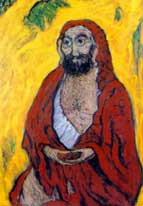 Dogen mentions the game of Go exactly once in his writings, in the “Spring and Autumn” fascicle of SBGZ. That’s of deep interest to both go players and Zen students. What did the old geezer have to say?
Dogen mentions the game of Go exactly once in his writings, in the “Spring and Autumn” fascicle of SBGZ. That’s of deep interest to both go players and Zen students. What did the old geezer have to say?
Maybe that Go is an analogy for englightenment? Sounds promising, and that’s the interpretation of Bill Cobb in his essay Empty Board:
There is good evidence that ancient Chinese and Japanese Zen masters associated playing Go with the experience of enlightenment. The writings of the thirteenth century Japanese Zen master Dogen contain a clear example.
Let’s take a look at this. “Spring and Autumn” is nominally about heat and cold. It starts with a dialog between Tozan (Dongshan) and a disciple, where the disciple asks the master, “When cold or heat comes, how can we avoid it?”, and the master answers, “Why don’t you go where there is no cold or heat?”
Dogen then paraphrases a commentary by Wanshi, a Chinese Zen master from the twelfth century, on the case (my translation):
Discussing this is like two players playing Go, where you’ve got to answer my move if you don’t want to get taken for a ride. You won’t grasp what Tozan is saying until you’ve internalized this.
Wanshi has changed the subject. He is no longer talking about heat and cold—he’s talking about the nature of dialog. He’s saying that dialog, like a game of go, is an interaction between two active players. We must, he tells us, understand the nature of dialog in order to understand this particular dialog between Tozan and the disciple, and by extension the relationship between teacher and disciple. If Wanshi were giving this talk today, he’d probably be using tennis instead of go as an example.
Dogen now comments on the commentary:
Sticking with the go analogy for now, the real question is what’s happening with the two players. The minute you talk about two players playing go, you’ve become a bystander, which is no good because bystanders can’t play go. Playing go means one player and his opponent facing each other, it must be said.
Dogen didn’t like Go, which had a reputation as a gambling game and a waste of time. Far from comparing Go to enlightenment, he didn’t even really like Wanshi’s use of Go in the analogy.
Incredibly, instead of “bystander” Tanahashi has “a handicap of eight stones”, a mistake also found in the Nishijima/Cross rendition, involving the word “hachimoku”, which in this context clearly has the “bystander” meaning (“okame hachimoku”). And instead of “playing go means one player and his opponent facing each other”, Tanahashi gets ultra-creative with “you play Go by yourself; the opponents become one”, which also has no relationship with the original.
What’s really happening here is that in typical Dogenesque fashion, our friendly master is changing the subject once again—this time to the question of involvement, and the way that our language with expressions such as “two players playing go” itself facilitates separation by helping to hide the fact that I myself am one of those two players!
Continuing with my translation:
In addition, though, you should explore Wanshi’s “you’ve got to answer my move” with an engaged mind. Wrap your body around it to study it. “You’ve got to answer my move” is saying that you can never be me. Nor must you skip over his “if you don’t want to get taken for a ride” part.
For “you can never be me”, Tanahashi has “’you’ are not yet ‘you’,” whatever that was supposed to mean.
Cobb now gives an exuberant summary based on the incorrect Tanahashi translation:
Here we have a striking example of the use of Go by ancient Zen masters to explain enlightenment. Dogen speaks of the experience of enlightenment as “dropping off body and mind”, which means losing one’s sense of being a separate being, ultimately distinct from the world and from others. He and Hongzhi are suggesting that playing Go involves this experience of non-separateness.
He goes on:
If you’re curious about what nirvana is like, the next time you start a game take the advice of ancient Zen masters and just play, not trying to do anything else. Let the game “swallow you up.”
But you already get the idea.
The bottom line: Dogen had nothing special to tell us about go or go players. But we can certainly enjoy Dogen’s insights on the relationship between language and subjectivity. And we can remind ourselves of how important it is to get translations right, especially when they are going to be used by other scholars as a basis for further commentary.
(Thanks to John Fairbairn for his help.)
 Today we’ll continue (previous post) our analysis of the first sentence of Dogen’s “Gabyo” (“Painting of a Ricecake”, or “Images of Donuts”). Let’s consult a Japanese commentary by Nishijima-sensei:
Today we’ll continue (previous post) our analysis of the first sentence of Dogen’s “Gabyo” (“Painting of a Ricecake”, or “Images of Donuts”). Let’s consult a Japanese commentary by Nishijima-sensei:
 I’ve been looking at Dogen’s “Gabyo” (“drawing rice-cakes”, or, as I prefer, “drawing donuts”), and, in an extreme case of spending too much time on individual sentences, have gotten stuck on the very first line.
I’ve been looking at Dogen’s “Gabyo” (“drawing rice-cakes”, or, as I prefer, “drawing donuts”), and, in an extreme case of spending too much time on individual sentences, have gotten stuck on the very first line. “You always try to fit the original word to your understanding, instead of the other way round. But a good translator cannot be like that.”
“You always try to fit the original word to your understanding, instead of the other way round. But a good translator cannot be like that.” Dogen mentions the game of Go exactly once in his writings, in the “Spring and Autumn” fascicle of
Dogen mentions the game of Go exactly once in his writings, in the “Spring and Autumn” fascicle of  As mentioned in
As mentioned in  In the “Twining Vines” (Katto) fascicle of his Shobo Genzo, Dogen retells the story of how Bodhidharma (image), on his deathbed, queried his four disciples as to their understanding. The first three gave verbal answers, to which Bodhidharma replied that they had attained his skin, flesh, and bones, respectively. Eka (Huike), in contrast, simply prostrated himself three times (awkwardly, one imagines, since he was missing an arm) and returned to his place. Commenting “You have got my marrow”, Bodhidharma then annointed him his successor.
In the “Twining Vines” (Katto) fascicle of his Shobo Genzo, Dogen retells the story of how Bodhidharma (image), on his deathbed, queried his four disciples as to their understanding. The first three gave verbal answers, to which Bodhidharma replied that they had attained his skin, flesh, and bones, respectively. Eka (Huike), in contrast, simply prostrated himself three times (awkwardly, one imagines, since he was missing an arm) and returned to his place. Commenting “You have got my marrow”, Bodhidharma then annointed him his successor. Dogen translations which are actually readable seem to be getting more popular. Now Michael Eido Luetchford (picture), whom I had the pleasure of meeting last week, has presented us with his highly accessible version of
Dogen translations which are actually readable seem to be getting more popular. Now Michael Eido Luetchford (picture), whom I had the pleasure of meeting last week, has presented us with his highly accessible version of 
 Gabyo is one of my favorite Dogen essays. Literally, it means “painted ricecake”, but I would update that and call it “drawing donuts”. In this chapter of Shobo Genzo, Dogen ponders the meaning of the ancient Chinese saying that a painted ricecake cannot satisfy your hunger—or, as I would say, a drawing of a donut can’t fill you up.
Gabyo is one of my favorite Dogen essays. Literally, it means “painted ricecake”, but I would update that and call it “drawing donuts”. In this chapter of Shobo Genzo, Dogen ponders the meaning of the ancient Chinese saying that a painted ricecake cannot satisfy your hunger—or, as I would say, a drawing of a donut can’t fill you up.